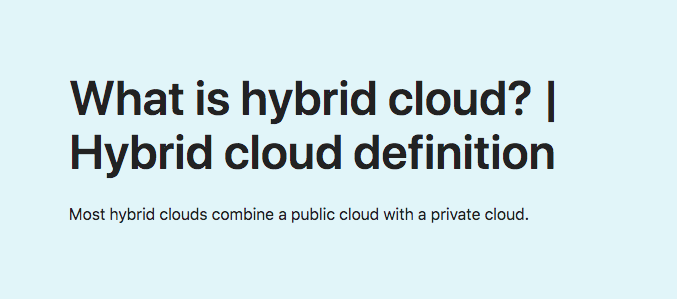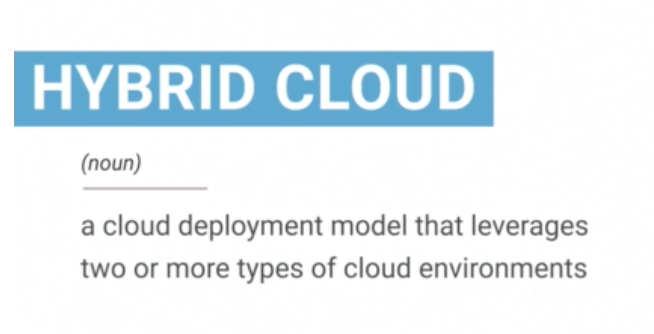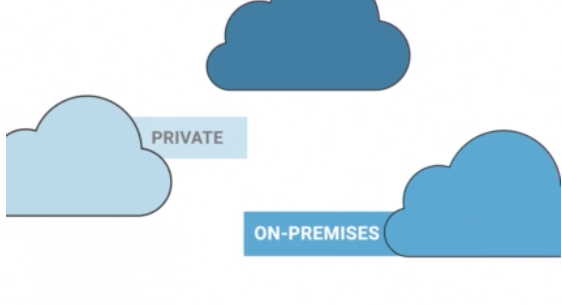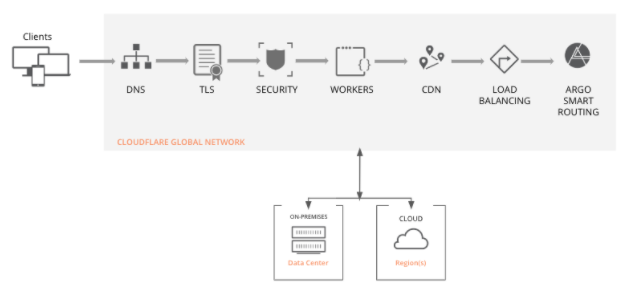The majority of hybrid clouds mix a public and a private cloud. A hybrid cloud combines public cloud resources with private cloud or on-premise resources. The goal is to make use of both sorts of environments.
Cloud computing refers to the on-demand availability of computer system resources, particularly data storage and processing power, without the user having to manage them directly. The phrase refers to data centres that are accessible over the Internet to a large number of people.

Learning Outcomes
You will be able to do the following after reading this article:
- Find out what the term “hybrid cloud” implies.
- Recognize the many types of cloud environments that may be integrated in a hybrid cloud.
- What is the difference between a multicloud and a hybrid cloud environment?
- Examine the benefits and drawbacks of hybrid clouds.
What does ‘Hybrid Cloud’ mean?


A hybrid cloud is one that combines two or more cloud environments. Public* and private clouds** are combined in hybrid cloud installations, which may also incorporate on-premises legacy infrastructure. For a cloud to be genuinely hybrid, these many cloud environments must be tightly linked, effectively acting as one unified infrastructure. At least one public cloud is present in almost all hybrid clouds.

A hybrid cloud is similar to a hybrid vehicle. Hybrid automobiles combine two very different technologies: a gasoline-powered engine and electric power. Each technology works in a unique way, and each has its own set of advantages and disadvantages. When the two are mixed successfully, however, the result is a vehicle that is more fuel efficient than most gasoline-only vehicles while also being more powerful than most all-electric vehicles. Hybrid clouds, on the other hand, integrate the advantages of several cloud platforms for increased efficiency and usefulness.
Hybrid clouds have a variety of applications. A company may use its private cloud for some services and its public cloud for others, or it may utilise the public cloud as a backup for its private cloud. They can also use the public cloud to manage peak demand while retaining the majority of their operations in their own private cloud.
For further information on how cloud technology works. (See What Is the Cloud?).
Private Clouds
Private clouds and on-premise solutions provide businesses more control and security over their computer resources. The organisation is in charge of all infrastructure and may tailor it to meet its unique requirements. However, running and maintaining a fully proprietary IT system is expensive, especially as a firm expands and more server space is required.
Public Clouds
Public clouds, on the other hand, enable scalability and are easier to administer because the infrastructure is maintained by the cloud provider. While using a public cloud is less expensive, it may limit your flexibility and control over important aspects like storage security.
What are the types of environments found in hybrid clouds?
A “hybrid cloud” is defined as a mix of two or more of the environments described below:
*Public cloud: A public cloud is a cloud service provided by a third-party provider and may contain servers located in one or more data centres. A public cloud is a cloud that is shared by a number of businesses. Individual servers can be shared by several organisations using virtual machines, a circumstance known as “multitenancy,” because numerous companies are renting server space on the same physical server.
**Private cloud on-premises: A private cloud is a data centre that is only dedicated to one enterprise. A private cloud’s servers aren’t used by anybody else’s software, files, or data. Private clouds on-premises are managed and protected by the organisations themselves, rather than by a third-party provider.
Hosted private cloud: This is similar to an on-premises private cloud in that the servers are solely dedicated to one company. A hosted private cloud, on the other hand, does not have cloud servers in an organization’s offices; instead, a third-party provider hosts and maintains the cloud servers in one or more faraway data centres, and the business connects to the cloud through the Internet rather than an internal network. There is no multitenancy, unlike a public cloud, and the cloud servers are not shared with other businesses.
On-premises (legacy): On-premises (legacy) implementations do not make advantage of cloud technologies. Instead, companies who use this approach purchase software licences, build and maintain hardware on their premises, and instal software locally on staff PCs, as is customary. In other words, instead of using Google Docs, staff would use Microsoft Word or another software that was already installed and running on their computers.
What is the difference between hybrid cloud and multicloud?

A hybrid cloud mixes a public cloud with another kind of environment, whereas a multicloud deployment combines many public clouds. A multicloud deployment is more like merging several varieties of apples than hybrid clouds, which blend apples and oranges.
In the same way that a rectangle may be a square, but not all rectangles are squares, a multicloud can also be a hybrid cloud if it combines different types of cloud environments in addition to using numerous public clouds. A hybrid cloud deployment, on the other hand, can be multicloud if it employs several public clouds.
How do the different environments communicate with each other in a hybrid cloud?
The connectivity between the various clouds is critical for a hybrid cloud to function properly. Public clouds, private clouds, and on-premises infrastructure can all be linked in a number of ways, including:
- APIs (Application Programming Interfaces)
- VPNs (Virtual Private Networks)
- WANs (Wide Area Networks)
An business isn’t running a hybrid cloud if there isn’t a functioning link across clouds – they’re just running two or more distinct cloud environments in parallel, and they won’t gain the benefits of hybrid cloud deployments.
What are the advantages of using a hybrid cloud architecture?
- Flexibility: Hybrid clouds enable switching to a different cloud deployment method easy. For example, if a company decides to migrate entirely to the public cloud, it will be easier if some of its business operations or storage is already done so.
A broader range of technology: A firm can use a public cloud to operate technologies that would be impractical to run in a private cloud, such as big data processing.
To avoid downtime, make backups: A firm may rely on the other cloud if one crashes or fails, preventing service disruptions. Multicloud installations also benefit from this sort of redundancy. - Meet demand spikes: A firm may operate most of its processes in a private cloud, then use a public cloud for extra processing capacity to meet an unexpected increase in workload, such as when much more people than usual visit an eCommerce site on Black Friday. Because a task “bursts” from one cloud to a bigger cloud, this approach is known as cloud bursting.
Cost-cutting opportunities: Keeping an internal data centre, such as a private cloud, up and running may be costly and time-consuming. By shifting certain activities to the public cloud, a company may reduce expenses by not having to maintain as much technology on-premises. - Keep sensitive data on-premises: Some businesses handle sensitive information such as credit card details, medical records, or financial information. Keeping sensitive data on-premises provides a business a lot more control over the security mechanisms in place to protect it. An business can store sensitive data in a secure private cloud and use public clouds to run the rest of its apps in a hybrid cloud deployment.
What are some of the disadvantages of a hybrid cloud architecture?
- Increased attack surface: As network infrastructure grows more sophisticated, an attacker is more likely to identify a weakness to exploit. Strong security safeguards can be implemented in a single cloud, such as a private cloud. However, if you utilise numerous clouds from various providers, not all of them will have the same level of security.
- Integrations that are more complicated: The ability to link and orchestrate multiple types of clouds is critical. As a result, installing a hybrid cloud requires more steps than adopting a single public cloud or a single private cloud, because the connecting technologies – such as a VPN – must also be set up and maintained.
- Complicated to secure: While an on-premises private cloud runs behind the company firewall, a hosted private cloud or public cloud does not. A company may need to use multiple security products, some for their on-premises cloud and some for their public cloud, to keep their data safe. In addition, it might be hard to confirm a user’s identity across several clouds.
How does a Cloud company integrate with hybrid cloud deployments?

The Cloud global network businesses lie between end users and the infrastructure of Cloud customers, safeguarding both users and corporations while also speeding traffic to and from the users. Cloud services, including hybrid cloud and multicloud, may be put in front of any sort of network infrastructure.
RELATED CONTENT
- What Is the Cloud?
- What Is Hybrid Cloud?
- What is Cloud Migration?
- What Is a Cloud Firewall?
- What Is Multicloud?
- What is Software-as-a-Service (SaaS)?






